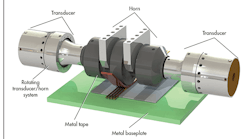This file type includes high-resolution graphics and schematics when applicable.
Fabrisonic uses ultrasonic additive manufacturing (UAM), which is a solid-state 3D-printing process for metals that uses sound waves to merge layers of metal foil. The process produces true metallurgical bonds with full density and works with a variety of metals, including but not limited to aluminum, copper, stainless steel, and titanium.
The UAM process involves building up solid metal objects through ultrasonically welding a succession of metal tapes into a three-dimensional shape, to create the detailed features of the resultant object. The rolling ultrasonic welding system consists of ultrasonic transducers and a (welding) horn. The vibrations of the transducers are transmitted to the disk-shaped welding horn, which in turn creates an ultrasonic solid-state weld between the thin metal tape and baseplate. The continuous rolling of the horn over the plate welds the entire tape to the plate.
By welding a succession of tapes, first side-by-side and then one on top of the other (making sure to stagger layers so that the seams do not overlap), it is possible to build a solid metal part. A machining operation adds features to the part, remove excess tape material, and true up the top surface for the next stage of welds. Thus, the so-called “additive manufacturing” involves both additive and subtractive steps to arrive at a final part shape.


